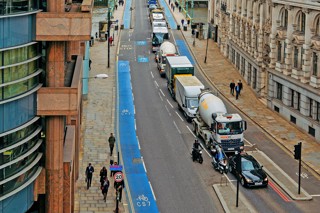Not a week goes by without hearing of another scheme or comment regarding the operation of trucks in our cities, particularly in central London. In last month’s feature, we followed a typical truck distribution across the capital, travelling from west to east, witnessing the various hazards that typify these operations.
In simple terms, they revolve around the sharing of the road by trucks with other road users, with an emphasis on cyclists due to the much publicised accidents that have occurred over the past few years.
The recent comments by Prime Minister David Cameron indicate that the issue of trucks, people and cyclists in the city is not one that’s going to go away. In fact, it appears battle lines are only just beginning to be drawn.
According to reports, Cameron told the All Party Parliamentary Group on Cycling he would ask Patrick McLoughlin, the transport secretary, to investigate the possibilities of several measures to improve cyclist safety, including the possibility of banning trucks in the city.
The Road Haulage Association (RHA) was quick to defend the industry, arguing that trucks have been singled out as the scape goat. “The road haulage community is acutely aware and troubled by the fatalities involving HGVs and cyclists in London and we note that there are many hundreds of serious injuries to cyclists (more than 400 last year), although very few of those involve lorries,” it said. “Per mile, buses are three times more likely to be involved in a serious injury incident with a cyclist than HGVs”.
This is not the first time a call to ban trucks from our cities has been muted. Then, as now, the reason was traffic pollution and the potential harm of ‘dirty, smelly’ trucks in an urban environment. Of course, with the introduction of the European Emission levels in 1993, we have seen the effective reduction of harmful emissions making today’s urban truck, in some cases, emitting air cleaner than the surrounding area. This, coupled with the congestion charging scheme and Low Emission Zone (LEZ), has seen trucks contribute to a cleaner and more sustainable London.
As with emissions, back in the 80s and 90s, and safety today, the issue quickly becomes a case of either banning trucks completely, and therefore taking away the problem totally, or controlling trucks within the city environment. History has shown us that the basic premise of trucks and people together in a confined space can be achieved with careful thought and enforcement of appropriate guidelines.
The total ban option
It is worth considering the consequences of a total ban on trucks from the centre of our cities. For instance, how would goods and services deliveries, as well as building works, go about their business?
The problems that halting deliveries would cause are probably a step too far for most people. In practical terms, banning trucks would, in all probability, put more vans on the road, increasing congestion and the likelihood of traffic accidents. This is also the view of the Freight Transport Association (FTA).
“Even a medium-sized lorry would have to be replaced with 10 vans – which means overall safety would not be improved, let alone the emissions and congestion consequences”, explains Christopher Snelling, head of urban logistics at the FTA. “It has to be remembered that we don’t choose to deliver at peak times on a whim – our customers need goods at the start of the working day.”
Many have speculated that London mayor Boris Johnson has looked at a rush-hour lorry ban but ruled it out, citing the fact that transport activity would be forced to the surrounding hours, and that’s when fatalities happen.
Therefore, even a rush-hour ban, let alone a complete one, would make inner city logistics extremely difficult. London’s transport commissioner Sir Peter Hendy said that “the essential role that freight plays in any city is vast, and none more so than London, so a total ban of trucks in the city would not be practical”.
Jack Semple, at the RHA, added: “Banning lorries from delivering into London as proposed by some is not the way forward. It is far from clear that it would reduce fatalities and it would be likely to have a range of unintended consequences, including a big increase in the use of vans, added congestion and pollution, and a massive increase in the costs of collecting and delivering goods and materials in London.”
Alternatives to a total ban
With a total city centre ban on trucks impractical and even a rush hour ban currently a non-starter, it may be more practical to look at what alternatives are available.
Perhaps the major conclusion from the above shows all road users have a role to play, and this is certainly the view of the trade associations. Snelling explains: “All road users have a role to play in improving road safety. Better awareness, training and behaviour is needed on all sides to make our roads as safe as they can be.”
From a truck operator’s perspective, we have seen various initiatives over the last few years to help distribution. In particular, construction companies build greater safety awareness into all aspects of the transport operation. At the moment, there are various schemes, mainly focused on central London, designed to control trucks. These are:
FORS
The Fleet Operators Recognition Scheme (FORS) aims to help transport users meet their legislative requirements, as well as helping to increase efficiency, reduce costs and win work, but it’s a voluntary scheme so take-up is limited.
CLOCS
The Construction Logistics and Cyclist Safety initiative (CLOCS) was launched in 2013 as an industry response to a Transport for London-commissioned report. The programme has brought together developers, construction companies, operators, vehicle manufacturers and regulatory bodies to ensure that a road safety culture is embedded generally across the construction industry.
Due to CLOCS, over 25 construction clients require FORS accreditation as part of their contracts to help reduce collisions between trucks and all vulnerable road users.
Safer lorry scheme
The Safer Lorry Scheme is the latest initiative from the mayor, Transport for London (TfL) and London councils, giving the go-ahead for a London-wide ban on any lorry not fitted with safety equipment to protect cyclists and pedestrians.
It will commence operation on September 1, as soon as all of the 600 warning signs are in place, and will cover all greater London roads (except motorways) and require vehicles of more than 3.5 tonnes to be fitted with sideguards to protect cyclists from being dragged under the wheels in the event of a collision, along with Class V and Class VI mirrors, giving the driver a better view of cyclists and pedestrians around their vehicle.
The scheme will operate 24 hours a day, seven days a week, and will be enforced by the police, the DVLA and the joint TfL and DfT-funded Industrial HGV Taskforce (IHTF). The maximum fine for each breach of the ban will be £1,000. The operator will also be referred for consideration to the relevant traffic commissioner, who is responsible for the licensing and regulation of HGV operators.
Enforcement
Legislation without enforcement is of no practical use and that’s also the view of the RHA.
“Enforcement of existing regulations is also a key issue, in terms of the road haulage industry,” it said.
“The RHA has been calling for increased enforcement for many years now. The Industrial HGV Task Force, jointly funded by TfL and the DfT, when it was launched almost two years ago to make up for a deficit in this area. At the suggestion of the RHA, TfL has commissioned TRL to analyse the details of the Industrial HGV Task Force’s enforcement finding so that we can see what further lessons can be learned. We looked forward with keen interest to seeing TRL’s report.”
In fact, the Industrial HGV Taskforce has resulted in more than 4,000 vehicles being stopped, with 47 vehicles being seized, 2,000 roadworthiness prohibitions given to drivers and more than 1,000 fixed penalty notices issued. Added to this, the Metropolitan Police Service Commercial Vehicle Unit stopped over 5,000 vehicles, issued 811 PG9s, 866 FPNs and seized 46 vehicles.
Customers
Of course, the customers of clients delivering the goods can also have a tremendous impact on the use of safety equipment.
For instance, it is now mandatory for all new and existing contracts, for contractors and their sub-contractors who deliver to a TfL premises or site to adopt Work Related Road Risk cycle safety requirements. This is perhaps one of the greatest potential influences on delivering a safer city environment.
CommercialFleet view: A 24-hour ban on trucks in city centres may sound like a great idea in theory. Unfortunately, it just isn’t practical. So it becomes a control and negate issue, which should be welcomed by the industry. Ensuring trucks and other road users can safely use their share of the road in major cities is not impossible, as long as all parties play their part – van and truck operators, car drivers, cyclists and pedestrians.
That will be the only way we can truly minimise the risk of road incidents in congested urban environments.















Login to comment
Comments
No comments have been made yet.